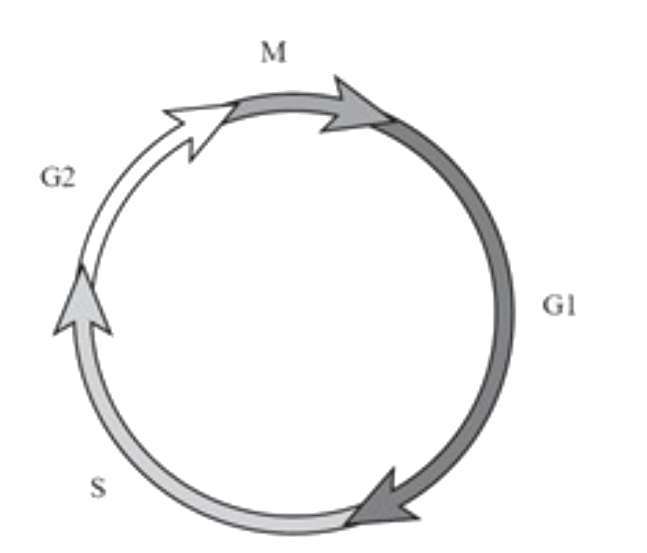Cell Cycle of an ordinary animal cell -
2n Mitosis −−−−−−−→n Fertilization −−−−−−−−−→2n Meiosis −−−−−−−−→2n
n Meiosis −−−−−−−→2n Fertilization −−−−−−−−−→2n Mitosis −−−−−−−→n
2n Meiosis −−−−−−−−→n Fertilization −−−−−−−−−→2n Mitosis −−−−−−−−−→2n
2n Fertilization −−−−−−−−−−−→(n) Mitosis −−−−−−→2n Meiosis −−−−−−−−→n
The correct Answer is:C
Step-by-Step Solution for the Cell Cycle of an Ordinary Animal Cell
1. Understanding the Cell Type:
- An ordinary animal cell is typically a diploid cell, which means it contains two sets of chromosomes. This is represented as 2n, where "n" is the number of chromosomes in a single set.
2. Meiosis for Gamete Formation:
- In the process of gamete formation, the diploid cell undergoes meiosis. Meiosis is a type of cell division that reduces the chromosome number by half, resulting in haploid cells (n). These haploid cells are the gametes (sperm and egg).
3. Fertilization:
- When a male gamete (sperm) and a female gamete (egg) fuse during fertilization, they form a zygote. The zygote is diploid (2n) because it contains one set of chromosomes from each parent.
4. Mitosis for Growth:
- After fertilization, the zygote undergoes mitosis to divide and multiply. Mitosis is a type of cell division that maintains the chromosome number, meaning the zygote remains diploid (2n) as it divides and grows into an organism.
5. Identifying the Correct Option:
- Now, we need to analyze the options given in the question:
- Option 1: 2n mitosis and fertilization - Incorrect, as mitosis does not reduce chromosome numbers.
- Option 2: 2n meiosis - Incorrect, as meiosis reduces the number of chromosomes.
- Option 3: 2n meiosis n fertilization 2n mitosis 2n - Correct, as it accurately describes the process.
- Option 4: 2n fertilization n - Incorrect, as fertilization results in a diploid zygote, not haploid.
6. Conclusion:
- The correct answer is Option 3: 2n meiosis n fertilization 2n mitosis 2n.
- An ordinary animal cell is typically a diploid cell, which means it contains two sets of chromosomes. This is represented as 2n, where "n" is the number of chromosomes in a single set.
- In the process of gamete formation, the diploid cell undergoes meiosis. Meiosis is a type of cell division that reduces the chromosome number by half, resulting in haploid cells (n). These haploid cells are the gametes (sperm and egg).
- When a male gamete (sperm) and a female gamete (egg) fuse during fertilization, they form a zygote. The zygote is diploid (2n) because it contains one set of chromosomes from each parent.
- After fertilization, the zygote undergoes mitosis to divide and multiply. Mitosis is a type of cell division that maintains the chromosome number, meaning the zygote remains diploid (2n) as it divides and grows into an organism.
- Now, we need to analyze the options given in the question:
- Option 1: 2n mitosis and fertilization - Incorrect, as mitosis does not reduce chromosome numbers.
- Option 2: 2n meiosis - Incorrect, as meiosis reduces the number of chromosomes.
- Option 3: 2n meiosis n fertilization 2n mitosis 2n - Correct, as it accurately describes the process.
- Option 4: 2n fertilization n - Incorrect, as fertilization results in a diploid zygote, not haploid.
- The correct answer is Option 3: 2n meiosis n fertilization 2n mitosis 2n.
Topper's Solved these Questions
- CELL BIOLOGY (CELL STRUCTURE, FUNCTION & CELL DIVISION)BOOK - ALLENCHAPTER - CELL BIOLOGY (CELL STRUCTURE, FUNCTION & CELL DIVISION)EXERCISE - EXERCISE-II (Previous Year Questions)
2 Videos
- CELL BIOLOGY (CELL STRUCTURE, FUNCTION & CELL DIVISION)BOOK - ALLENCHAPTER - CELL BIOLOGY (CELL STRUCTURE, FUNCTION & CELL DIVISION)EXERCISE - EXERCISE-II (AIPMT Pre. 2010)
2 Videos
- CELL BIOLOGY (CELL STRUCTURE, FUNCTION & CELL DIVISION)BOOK - ALLENCHAPTER - CELL BIOLOGY (CELL STRUCTURE, FUNCTION & CELL DIVISION)EXERCISE - EXERCISE-IV (Assertion & Reason) (Directions for Assertion & Reason questions)
20 Videos
- BREATHING AND EXCHANGE OF GASESBOOK - ALLENCHAPTER - BREATHING AND EXCHANGE OF GASESEXERCISE - S
33 Videos
- CELL CYCLE AND CELL DIVISIONBOOK - ALLENCHAPTER - CELL CYCLE AND CELL DIVISIONEXERCISE - EXERCISE
61 Videos
Similar Questions
What is the average cell cycle span for a mammalian cell?
View SolutionWhat is the average cell cycle span for a mammalian cell?
View SolutionWhat is the average cell cycle span for a mammalian cell?
View SolutionWhat is the average cell cycle span for a mammalian cell?
View SolutionWhat is average cell cycle span for a mammalian cell?
View SolutionHow does cytokinesis in plant cells differ from that in animals cells ?
View SolutionCell structures that are exclusively found in animal cells but not in plant cells are
View SolutionThe below image summaries the cell cycle of a typical eukaryotic cell. Using the image as a reference, determine the activities occurring at the G1 Phase of the cell cycle .

View SolutionThe suicidal bag of an animal cell is :-
View SolutionHow does cytokinesis in plant cells differ from that in animal cells?
View Solution

